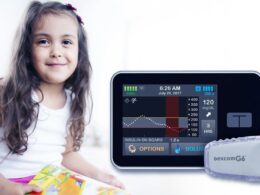institute for continuous
health transformation
Joaquim Cardoso MSc
Senior Advisor for
Continuous Health Transformation
and Digital Health
January 10, 2023
EXECUTIVE SUMMARY
An independent NICE committee has recommended the use of hybrid closed loop systems for managing blood glucose levels in type 1 diabetes, describing the technology as a step towards an artificial pancreas.
- The hybrid closed loop system comprises of a continuous glucose monitor sensor attached to the body, which transmits data to a body-worn insulin pump that uses the data to calculate how much insulin needs to be delivered to keep blood glucose levels within a healthy range.
- NICE has recommended that people who are unable to control their condition despite using an insulin pump are offered the technology if their long-term average blood glucose levels are indicating they are at risk of long-term complications, …
- around 105,000 people in England and Wales could be offered the technology.
- The cost for the technology is currently £5,744, which is higher than what NICE considers a cost-effective use of NHS resources.
- NICE is working with NHS England and industry to agree a cost-effective price for the systems on behalf of relevant health bodies.
DEEP DIVE

New “artificial pancreas” technology set to change the lives of people having difficulty managing their type 1 diabetes
Around 105,000 people with type 1 diabetes could benefit from NICE’s draft recommendation
Nice UK
10 January 2023
People who are struggling to manage their type 1 diabetes could be offered new technology to help them control their condition with little human input.
In draft guidance, an independent NICE committee has recommended the use of hybrid closed loop systems for managing blood glucose levels in type 1 diabetes — technology that has been described as a step towards an artificial pancreas.
Real world NHS trials has provided the data which has allowed NICE to consider wider use of the technology which allows a person with type 1 diabetes to go about their day-to-day life without having to monitor if their blood glucose levels are too high or too low.
If type 1 diabetes is not well controlled, people are at risk of long-term complications of hyperglycaemia, including blindness, amputations, or kidney problems.
The hybrid closed loop system comprises of a continuous glucose monitor sensor attached to the body. This transmits data to a body worn insulin pump.
This uses the data to run a mathematical calculation to work out how much insulin needs to be delivered into the body to keep blood glucose levels within a healthy range.
NICE has recommended people who are unable to control their condition despite using an insulin pump, or real-time or intermittently scanned continuous glucose monitoring, are offered the technology if their long-term average blood glucose levels are indicating they are at risk of long-term complications.
That is, an average HbA1c reading of 8.0% or more when the NICE guideline recommends people should aim for a HbA1c level of 6.5% or lower to minimise the risk of long-term complications from diabetes.
People with type 1 diabetes who are pregnant or planning a pregnancy are also eligible, because blood glucose levels are harder to manage during this time.
In total, around 105,000 people in England and Wales could be offered the technology.
The draft recommendations also require NHS England to agree a cost-effective price for the systems on behalf of relevant health bodies. At present an average annual cost for the technology is £5,744, which is higher than what NICE considers a cost-effective use of NHS resources.

What people said?
Mark Chapman, interim director of Medical Technology at NICE, said: “Some people living with type 1 diabetes struggle to manage their condition, even though they are doing everything asked of them by their diabetes team. This technology is the best intervention to help them control their diabetes, barring a cure.
“At a time when the number of people with diabetes is rising, we have to focus on what matters most to people who use NHS services by balancing recommending the best care with value for money.
“Our committee has reviewed the real-world data generated by the NHS and evidence generated by randomised controlled trials which show there are clear benefits of recommending the technology’s use. We look forward to working with NHS England and industry to ensure a cost-effective price can be reached which is fair to taxpayers.”
Professor Partha Kar OBE, national specialty advisor for diabetes at NHS England, said: “This technology has been proven to give the best control for managing type 1 diabetes and should make things like amputations, blindness, and kidney problems possibly a thing of the past.
“We have seen fantastic results from the real-world trials which have taken place and thank you to NICE for their review of the evidence and subsequent conclusions. The quality of life this technology gives to those using it is huge.
“We look forward to working with industry colleagues to help ensure this technology can be made available to those who need it.”
Health Minister Helen Whately said: “People living with type 1 diabetes face the constant stress of needing to monitor their blood glucose levels — sometimes multiple times a day — just to stay healthy and avoid complications. This new technology could ease the burden on patients and allow them to manage their condition more easily.
“We are determined to harness the latest innovative technology to improve outcomes for patients, reduce serious complications and ultimately ease pressure on the NHS. We look forward to seeing the outcome of the consultation.”

At present, the standard care for type 1 diabetes involves regularly measuring blood glucose levels by using finger-prick blood testing or by using a continuous glucose monitor (real-time or intermittently scanned).
Blood glucose levels are managed with multiple daily insulin injections or by using a pump to inject insulin under the skin.
It is estimated that approximately 278,000 people in England and Wales are living with type 1 diabetes.
In type 1 diabetes, a person’s blood glucose level becomes too high (hyperglycaemia) because there is no, or very little, production of insulin by the pancreas.
Blood glucose levels can only be regulated by giving insulin to prevent hyperglycaemia which is when a person’s blood glucose level becomes too high and could result in blindness, amputations, or kidney problems.
Blood glucose levels can only be regulated by giving insulin to prevent hyperglycaemia which is when a person’s blood glucose level becomes too high and could result in blindness, amputations, or kidney problems.
A consultation has begun on the draft recommendations and consultees can have their say via nice.org.uk until Tuesday 31 January 2023.
Originally published at https://www.nice.org.uk on January 10, 2023.
People mentioned
- Mark Chapman, interim director of Medical Technology at NICE
- Professor Partha Kar OBE, national specialty advisor for diabetes at NHS England
- Health Minister Helen Whately












